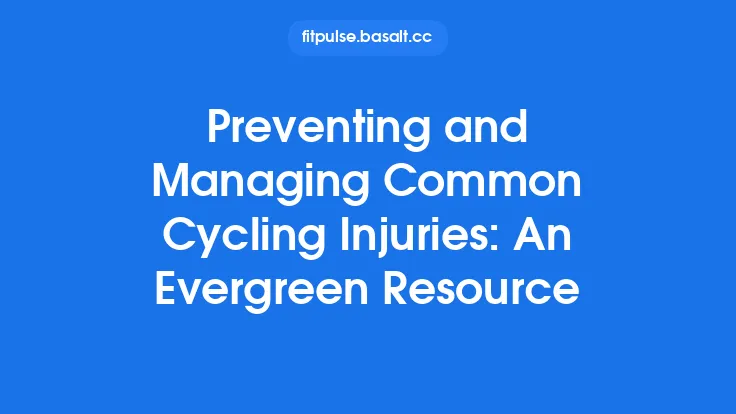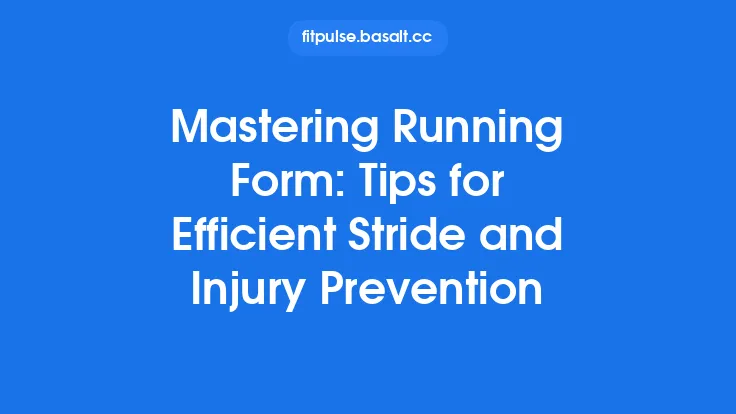Running is one of the most accessible forms of exercise, yet even seasoned athletes can fall victim to injuries that derail progress and diminish the joy of the sport. Understanding why injuries happen, recognizing early warning signs, and implementing evidence‑based prevention strategies are essential for anyone who wants to stay on the road, trail, or track for the long haul. This guide delves into the most common running‑related ailments, explores the underlying biomechanical and training factors that contribute to them, and offers practical, science‑backed tips to keep you injury‑free while you chase your performance goals.
The Anatomy of a Running Injury
Running places repetitive stress on the musculoskeletal system. When the load exceeds the body’s capacity to adapt, tissue damage can occur. Three primary mechanisms drive most running injuries:
- Overuse (Cumulative Load) – Repeated micro‑trauma from high mileage, rapid increases in intensity, or insufficient recovery.
- Biomechanical Stress – Abnormal joint alignment, muscle imbalances, or faulty gait patterns that concentrate forces on specific structures.
- External Factors – Hard or uneven surfaces, inappropriate footwear, and environmental conditions that alter loading patterns.
By addressing each of these pillars—load management, biomechanics, and environment—you can dramatically reduce the likelihood of injury.
Common Running Injuries and Their Root Causes
| Injury | Typical Symptoms | Primary Contributing Factors |
|---|---|---|
| Shin Splints (Medial Tibial Stress Syndrome) | Dull, aching pain along the inner shin, worsened by uphill running or prolonged activity. | Sudden mileage spikes, excessive pronation, weak calf muscles, running on hard surfaces. |
| Iliotibial (IT) Band Syndrome | Sharp pain on the outer knee, especially during the latter part of a run. | Overstriding, excessive hip adduction, weak gluteus medius, repetitive downhill running. |
| Plantar Fasciitis | Stabbing pain at the heel or arch, most intense with the first steps after rest. | High arches or flat feet, tight calf/achilles complex, abrupt increases in training volume. |
| Achilles Tendinopathy | Stiffness or soreness at the back of the ankle, especially after warm‑up. | Sudden speed work, limited ankle dorsiflexion, calf muscle tightness, inadequate recovery. |
| Patellofemoral Pain Syndrome (Runner’s Knee) | Diffuse knee pain aggravated by hills, stairs, or prolonged sitting. | Weak quadriceps, excessive knee valgus, poor hip stability, rapid training progression. |
| Stress Fractures | Localized bone pain that worsens with activity and improves with rest. | Low bone mineral density, abrupt mileage jumps, repetitive high‑impact training on hard surfaces. |
| Hamstring Strain | Sudden sharp pain in the back of the thigh, often during sprint intervals. | Inadequate hamstring flexibility, muscle fatigue, insufficient warm‑up intensity. |
Understanding the “why” behind each condition helps you target the specific preventive measures that matter most.
Load Management: The Cornerstone of Injury Prevention
1. Follow the “10 % Rule” (with nuance)
A classic guideline suggests limiting weekly mileage increases to no more than 10 % of the previous week. While useful as a baseline, the rule should be adapted to individual fitness, age, and injury history. For runners returning from a layoff or those with a history of overuse injuries, a more conservative 5 % progression may be prudent.
2. Incorporate “Step‑Back” Weeks
Every 3–4 weeks, schedule a recovery week where mileage is reduced by 20–30 %. This intentional dip allows soft tissue remodeling, replenishes glycogen stores, and reduces cumulative fatigue—key factors in preventing overuse injuries.
3. Vary Intensity and Terrain
Alternating easy runs with moderate‑pace workouts, and interspersing some runs on softer surfaces (e.g., grass or rubberized tracks), distributes load across different muscle groups and reduces repetitive impact on the same structures.
4. Listen to Your Body: The “Pain‑Scale” Check
Adopt a simple self‑assessment: on a scale of 0–10, rate any soreness or discomfort after each run. Persistent scores above 3 for more than 48 hours warrant a reduction in volume or a brief rest period. Early intervention is far less disruptive than waiting for a full‑blown injury.
Biomechanical Optimization
1. Gait Analysis and Footstrike Assessment
A professional gait analysis—whether in‑person with a sports therapist or via validated video analysis tools—can reveal excessive pronation, overstriding, or abnormal hip rotation. Addressing these patterns through targeted drills (e.g., high‑knees, butt kicks, and cadence work) can redistribute forces more evenly.
2. Strengthen Key Stabilizers (without prescribing a full program)
- Hip Abductors & Gluteus Medius – Essential for controlling knee valgus and reducing IT‑band strain.
- Calf‑Achilles Complex – Improves ankle dorsiflexion and buffers tibial stress.
- Core Musculature – Provides a stable platform for efficient force transfer.
Incorporating low‑volume, high‑quality activation exercises (e.g., side‑lying clamshells, single‑leg balance, and plantar‑flexor isometrics) a few times per week can reinforce proper mechanics without the need for a dedicated strength‑training regimen.
3. Optimize Cadence
A cadence of 170–180 steps per minute is often cited as a sweet spot for reducing impact forces. Use a metronome app or a simple song with a matching beat to practice slightly higher turnover during easy runs. Incremental cadence improvements can shorten stride length, limiting overstriding and the associated shock to the tibia and knee.
Environmental and Equipment Considerations
1. Surface Selection
Hard concrete delivers the highest impact forces, while softer surfaces (grass, synthetic tracks, packed dirt) attenuate shock. When possible, rotate between surface types to avoid chronic loading on the same musculoskeletal structures.
2. Footwear Fit and Wear
Even though a deep dive into footwear science is beyond this article’s scope, a few evergreen principles remain:
- Fit – Shoes should allow a thumb’s width of space at the toe box, with a snug heel to prevent slippage.
- Mid‑life Replacement – Most running shoes lose cushioning and structural integrity after 300–500 km. Mark the mileage on the outsole to know when it’s time for a new pair.
- Purpose‑Specific Shoes – If you regularly run on trails, a trail‑specific shoe with adequate grip and protective rock plates can reduce ankle sprains and foot bruising.
3. Climate and Hydration
Extreme heat or cold can alter muscle elasticity and joint lubrication. In hot conditions, schedule runs during cooler parts of the day and ensure adequate fluid intake to maintain tissue pliability. In cold weather, a proper warm layer helps preserve muscle temperature, reducing strain risk.
Recovery Strategies That Matter
1. Sleep Hygiene
Aim for 7–9 hours of quality sleep per night. During deep sleep, growth hormone secretion peaks, facilitating tissue repair and collagen synthesis—critical for tendon health and bone remodeling.
2. Active Recovery
Low‑intensity activities such as easy cycling, swimming, or brisk walking promote blood flow without adding significant mechanical stress. These sessions can be scheduled on “off” days to accelerate recovery from hard workouts.
3. Soft‑Tissue Work
- Foam Rolling – Helps release myofascial tightness in the calves, quadriceps, and IT band, improving range of motion.
- Massage or Self‑Myofascial Release – Periodic deep‑tissue work can break down adhesions that contribute to abnormal gait patterns.
4. Nutrition for Tissue Repair (Brief)
While a full nutrition guide is outside this article’s remit, ensure adequate protein (≈1.2–1.6 g/kg body weight daily) and micronutrients such as calcium, vitamin D, and magnesium to support bone and tendon health.
Early Detection and When to Seek Professional Help
- Pain vs. Discomfort – Normal post‑run soreness should fade within 24–48 hours. Persistent, localized pain that worsens with activity signals a potential injury.
- Swelling or Redness – Indicates inflammation; early intervention (ice, compression, elevation) can prevent escalation.
- Altered Running Mechanics – If you notice a limp, change in stride, or avoidance of a particular foot strike, consult a physical therapist or sports medicine physician promptly.
Timely assessment can differentiate a manageable strain from a stress fracture that requires imaging and a longer recovery timeline.
Building a Personal Injury‑Prevention Checklist
- Plan Weekly Mileage – Incremental increases, step‑back weeks, and surface variation.
- Perform a Quick Gait Check – Every 4–6 weeks, record a short video of your run and assess cadence, footstrike, and knee alignment.
- Schedule Strength/Activation Sessions – 2–3 short sessions per week focusing on hips, calves, and core.
- Monitor Pain Scale – Log any soreness >3 for more than two days.
- Track Shoe Mileage – Replace shoes at 300–500 km or when cushioning feels diminished.
- Prioritize Sleep and Hydration – Set a nightly routine and fluid targets.
- Incorporate Active Recovery – At least one low‑impact day per week.
- Review Checklist Monthly – Adjust based on training load, life stressors, and any emerging niggles.
By turning these steps into a habit, you create a proactive defense system that catches potential problems before they become setbacks.
Final Thoughts
Running offers unparalleled physical and mental benefits, but the sport’s repetitive nature makes injury prevention a continuous, dynamic process. By mastering load management, fine‑tuning biomechanics, respecting environmental cues, and committing to consistent recovery practices, you lay a solid foundation for a resilient, injury‑free running career. Remember: the goal isn’t just to run more—it’s to run smarter, longer, and healthier.





